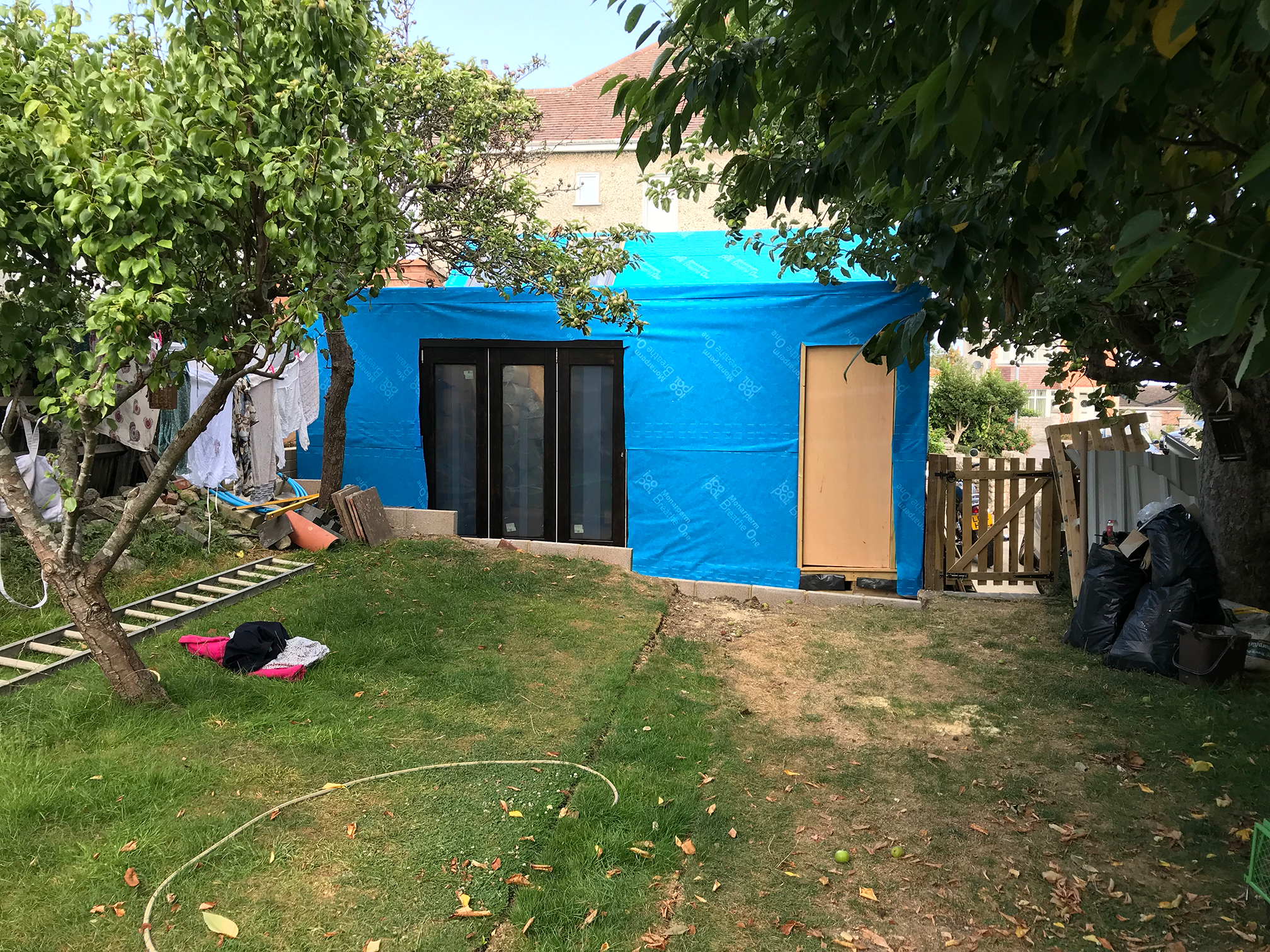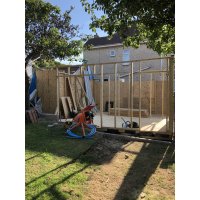This stage is largely about getting to watertight building stage, not even roof yet, but breathable membrane and doors / windows.
I started with a detailed drawing I did myself of the construction knowing pretty much what I wanted. This allowed me to build the materials list. Roofing was supplied by Clad co in Devon, which we picked up on a truck as order delivery takes a very long time. Timber, insulation materials and other sheeting materials were bought from Jewson's in Weymouth. I wanted bifold doors and decided the garage section would need two large velux type windows which I ordered from the internet. The doors in particular were unbelievably expensive initially until I found the right supplier. Some ranged from £2000 - £4000, just for a very modest three door setup. In the end they cost £800. The glass is a bit smaller than some (bigger surround) - they are wooden, although I actually prefer that.


I figured that as I initially wanted sips - ready made insulated sections of building which I found to be simply too expensive, I would have to construct something alike myself. Because the double skin has huge rigidity the building eventually is very strong indeed. This was just a simple job of sandwiching the insulation between two bits of board. Sips are in my opinion overly expensive, you are paying for the Lego like final product but actually recreating it is fairly easy. The material I found to use for insulation was called Actis Hybris which is brilliant. It comes in a roll, and unlike Kingspan etc it’s soft and much more giving when you cut it, and fills gaps better and is just as effective thermally - and it’s just as cheap. I cannot understate how good this stuff is. The waterproof breathable membrane is fairly standard stuff now and there is a range to choose from. The main construction material was basic timber 50 x 100mm section which was screwed together as a frame then had OSB 3 board fitted. As basic as it gets, but does the job admirably. As I say - the double layer basically makes the whole building extremely rigid. We didn’t have to worry about load bearing too much as it’s all so light. This is the joy of being free of traditional building materials like bricks and mortar.
Other than the doors and windows the whole construction was basically a timber frame with OSB board screwed to both sides, with insulation material inserted between - about 100mm thickness. Anyone can do it at this stage - everything is light and easy to carry, easy to fix. Very simple. Even the roofing is manageable in single sheets.
The first job is to construct the base. A large lattice structure is built on a very thick sheet of plastic that lines the concrete floor to prevent any water penetrating the base. Once the base lattice is built the hybris insulation is fitted between the timbers. The whole base then has OSB screwed on top to form a totally flat base like a table top. Finally the plastic sheet is then pulled up the sides and stapled into place forming a sound, waterproof and fixable bottom to the building. Base done.
The frame is then constructed on top, and this in turn is then boarded on the outside to form the building surface - including the roof. The whole lot is wrapped in breathable membrane all stapled in place with the doorways and windows cut out. It all comes down to meet the plastic wrap on the base making the building totally watertight. This means all further building materials are dry because they can be kept inside.
Two walls are slightly different as they are clad not only in wood and membrane, but the roofing tin. Both walls are hidden from sight - one facing the high side of the slope and the other facing the neighbouring property, furthest wall from the house. Of course in place there would be no room to screw in the tin cladding, which uses special waterproof tin screws. So it all has to be built 1m shy of the final position, skin, membrane and cladding fitted, then as gently as possible hammered into place with a sledge hammer. As the building is predominantly timber frame, it’s fairly light so this can be achieved. Finally the frame has the OSB board added to the remaining walls and roof, and it’s all wrapped in breathable waterproof membrane.
So Jason the builder basically got me to the stage of frame up, and two walls clad, and all walls and roof done, all covered in membrane. I fitted the bifold doors and windows myself - all came with instructions and were pretty easy to fit. Time to this stage four weeks. My builder left me to my own devices.
This stage - the building was weatherproof, and a vast majority of the construction materials were gone, and we were able to move back all the items that had previously been stored elsewhere making life much better in my main home.
Jobs now left to do.
- Roofing tin
- Fit two large side hinge garage doors - solid timber 2.4x1.2m
- Fit all insulation to interior and roof.
- Electrics
- Plumbing
- Data cabling
- Toilet
- Lighting
- Skin interior wall with OSB over all conduits
- All roofing and drainpipes
- Baton for cladding
- Main timber cladding
The roofing - also used as side cladding - is just light enough to man handle a single sheet into place. Large uniform corrugation makes it dead easy to fit. The colour blends into the sky pretty good as well making it less obtrusive - I went for goose grey. As mentioned Clad co is based in Devon so close enough to drive and pick up in a suitable vehicle. The system uses special screws but it’s all pretty easy to do. Well within the reach of the enthusiastic amateur.
This probably took two weekends to complete.



